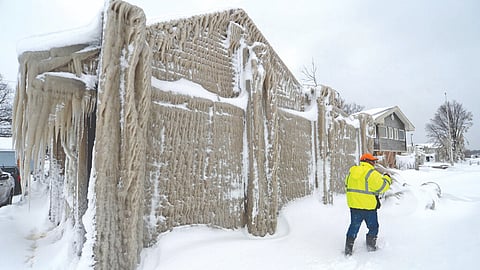

By Henry Fountain
The winter storm that ravaged much of the United States and Canada through Christmas was expected to be bad, and it was. Forecasters billed it as a “once in a generation” event even before ice began coating the steep streets of Seattle, white-out conditions spread from the Plains to the Midwest and more than 4 feet of snow was dumped on Buffalo, New York, in a storm that has killed more than two dozen people. The links between climate change and much extreme weather are becoming increasingly clear. In a warming planet, heat waves are hotter, droughts are prolonged, summer downpours are more severe. But when it comes to extreme winter weather like the recent storm, the links are less clear, and often the subject of vigorous scientific debate.
Winters, like the other seasons, have been getting warmer in the United States and elsewhere. An analysis by Climate Central, an independent research and communications group, found that winter temperatures in the United States have increased by more than 3 degrees Fahrenheit (a little less than 2 degrees Celsius) over the past half-century. In most places, winter is the fastest-warming season, and the warming is most pronounced in northern areas like the Great Lakes and the Northeast.
Those are average temperatures, however. Cold snaps still occur, and the one that began a few days before Christmas was extreme.
Meteorologists say it was caused by the polar vortex, a mass of cold Arctic air that moved southward into Canada and the United States. That air had become very cold sitting over the North Pole at a time of year when no sunlight reaches the region and the Arctic Ocean is frozen over. When it reached into Canada and the United States, the cold air, intruding between masses of warmer air, caused temperatures and air pressure to plunge drastically. The falling temperatures triggered a deep freeze in many locations, and the pressure changes generated strong winds.
The winds combined with the clash of air masses into what meteorologists call a bomb cyclone, a rotating, fierce storm that can bring heavy snow or rain and cause tidal surges in coastal areas.
What causes the polar vortex to make southward excursions like this, however, is hotly debated.
Some scientists say that rapid warming of the Arctic — it has warmed nearly four times faster than other regions — is responsible. As the Arctic warms, they say, the temperature difference between the pole and the tropics lessens. That leads to weakening of the high-altitude winds called the polar jet stream. which becomes more sinuous, or wavier, and allows the polar vortex to spread southward.
But many scientists say that while there is some evidence for the idea that Arctic warming weakens the jet stream, there is less to support the concept that this makes for a wavier pattern that allows for the polar vortex to wander. And at least one study has found that a short-term trend of a wavier jet stream and polar vortex excursions in the 1990s and 2000s, which prompted the development of the idea that Arctic warming affected the polar vortex, has not continued.
Research on the subject is continuing. “We’ve figured out a few strands of this question,” said Steve Vavrus, a climate scientist at the University of Wisconsin who was an author of a 2020 paper that reviewed current understanding of the subject in a paper several years ago. “I think we’ll continue to do so in coming years as more and more people research it.”
Henry Fountain is a journalist with NYT©2023
The New York Times
Visit news.dtnext.in to explore our interactive epaper!
Download the DT Next app for more exciting features!
Click here for iOS
Click here for Android